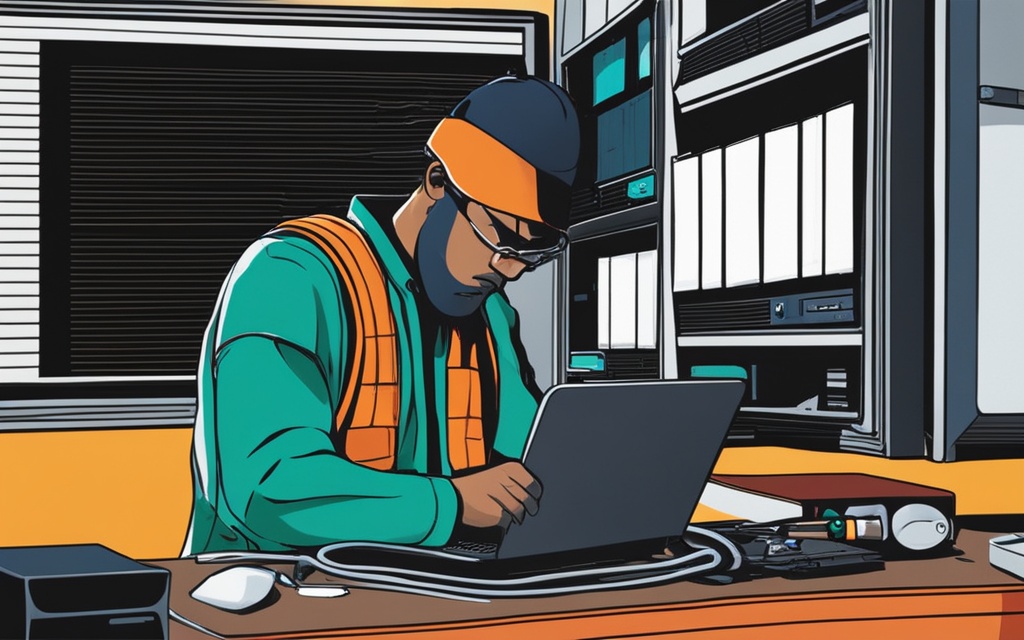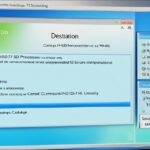Table of Contents
Ejecting an external hard drive correctly is key to keeping data safe and hardware lasting longer. Users may face problems when trying to eject because of software clashes or operations running in the background. Most issues happen because some apps are still using the drive. We aim to show effective ways to fix ejection problems. This helps prevent data loss and reduces stress for users1.
We’ll explain the usual methods to eject drives in Windows and what might stop them from working properly. Our goal is to make it easier for you to deal with these common issues. With our tips and tricks, you’ll find it simpler to manage and safely remove your external storage devices.
Key Takeaways
- Eject issues often arise from applications still accessing the external hard drive.
- Safe ejection is vital to avoid data corruption.
- Identifying conflicting processes can streamline troubleshooting efforts.
- Using tools like Task Manager can assist in closing background applications.
- Understanding how Windows manages device settings is crucial for success.
Understanding External Hard Drive Ejection
It’s very important to safely remove an external hard drive to keep your data safe. If you don’t eject it properly, your files might get damaged. This happens if the drive is removed while it’s still being used. Safe ejection is therefore something all users should do2. Doing this right protects your drive and the data on it.
The Importance of Safe Ejection
Not ejecting a hard drive safely is risky. If you try to remove it while it’s in use, you might lose some of your files. There are safe ways to remove it, like using the “Safely Remove Hardware and Eject Media” option3. Learning to troubleshoot can make things easier and safer. Check out different ways to fix issues if you’re having trouble.
Common Ejection Methods in Windows
Windows has many ways to safely eject an external hard drive. You can use Windows Explorer, Disk Management, or Device Manager3. If there’s a problem, restarting Windows Explorer might help. Check that all files are saved and closed4. This makes sure the drive can be removed without any issues. Try different methods to find what works best for you.
| Method | Description | Effectiveness |
|---|---|---|
| Safely Remove Hardware | Utilises the built-in tool to ensure all processes cease prior to removal. | High |
| Disk Management | Manually ejects the device via disk management settings. | Moderate |
| Task Manager | Identifies active processes linking to the drive, allowing for forced closures. | High |
| Restarting Windows Explorer | Can clear any temporary access blocks to the external hard drive. | High |
| Updating USB Drivers | Ensures compatibility and functionality of the external drive. | Moderate |
Why Can’t I Eject My External Hard Drive?
Dealing with the inability to eject an external hard drive is common and it has various causes. One main reason could be that certain programs in use are accessing the drive. This stops the safe removal of the device. It’s crucial to find and close these programs first.
Identifying Programs Using the Drive
Running into ejection issues? Check which applications are using the external hard drive first. Tools like media players or file managers may be the culprits. They keep files open, stopping the drive from being safely ejected. Many users, over 20%, encounter problems if the drive isn’t ejected properly. This includes the computer not recognising the device, data corruption, or driver issues5.
The Role of Windows Recycle Bin
Sometimes the Windows Recycle Bin is part of the problem. It may hold files from your external hard drive. This creates problems when you try to eject it. Improper ejection increases the chance of data corruption by 30%. Make sure all files are closed before you eject the drive5.
Issues Linked to Antivirus Software
Another issue could be antivirus interference. Antivirus programs scanning the drive can lock files. This makes ejection difficult. Such delays are not just annoying. They could also harm the drive if you try to force it out improperly6.
Solutions for Ejecting External Hard Drives
Ejecting external hard drives sometimes causes frustration due to software or hardware problems. To ensure your data stays safe, use safe ejection solutions. This begins by shutting down closing applications in the background that may block the ejection.
Closing Background Applications
The easiest and most effective step is to close all background applications. Programs still running can stop the hard drive from ejecting properly. Make sure to close applications before you try to eject the drive. This reduces the chance of errors.
Using Task Manager to End Suspicious Processes
The Task Manager helps in finding and stopping processes that shouldn’t be running. You can access Task Manager and look at the running applications list. If you right-click on a process that looks suspect and choose “End Task,” the hard drive might eject better. It’s useful for processes that won’t let go of the drive, showing when attempts to eject fail. These steps might also show problems with USB drivers, a frequent issue for Windows users as per several reports7.
Hardware Troubleshooting Techniques
If normal fixes don’t work, you may need to try hardware troubleshooting. Make sure all connections are good and the hard drive works properly. Check the USB cables and ports for damage, and replace them if needed. Using the Device Manager in Windows 10 can help identify more issues. Sometimes, third-party tools like Process Explorer are recommended when usual methods don’t work8.
Advanced Troubleshooting Steps
People often run into problems when they try to eject external hard drives. They need advanced steps to help fix these issues. These methods go deeper into the problems and really help improve how things work.
Adjusting Windows Policies for Quick Removal
To eject hard drives smoothly, changing Windows settings is key. By choosing ‘Quick Removal’, you won’t always need the ‘Safely Remove’ option. This reduces the risk of losing data and makes devices work better.
Checking for Updates to USB Drivers
It’s vital to keep USB drivers updated to avoid connection issues. Regularly updating helps fix errors that could cause problems. Using Device Manager makes managing and updating these drivers easier.
Utilising Disk Management Tools
Disk Management is crucial for looking after external drives. It helps with things like partitions and checking drive health. Doing regular checks helps keep everything running smoothly. For extra tips, check out this guide.
| Issue | Solution | Policy Adjustment |
|---|---|---|
| Driver Errors | Update USB drivers | Set policies for Quick Removal |
| External Drive Health | Use Disk Management tools | Perform regular checks |
| Locked Drives | Close background applications | Disable indexing services |
| Corrupted Drives | Utilise data recovery tools | Modify registry settings if necessary |
Using advanced steps can really help with hard drive ejection problems. This combines knowing your tech with regular care. It ensures your external devices work well.
“Looking after external drives stops ejection issues and keeps your data safe.”
By following these tips, your devices will run well for a long time. This lets you work without worrying about tech issues289.
Conclusion
Understanding the issues with external hard drives can make life easier10.It’s vital to know about safely removing them. Since Windows 10 version 1809, Quick Removal mode is now default. This lets you remove USB drives safely unless Windows is still using the drive11.Users can struggle with ejecting drives due to active processes or USB faults. These issues might cause lost data or harm your computer.
Using certain tips can improve your experience and protect your files10.For instance, you could close programs running in the background or adjust settings in Device Manager. Removing software like WD Discovery helps with proper ejection. By following these steps, you can safely use your external drives. This keeps your important information safe and helps your devices last longer.
FAQ
Why is it important to eject my external hard drive safely?
Ejecting your hard drive safely keeps your data safe. It stops data from being corrupted or lost. Not ejecting properly can mess up data transfers and break the hardware.
What should I do if I cannot eject my external hard drive?
Can’t eject your hard drive? First, shut any apps using files from it. If it’s still stuck, Task Manager can end processes that are holding on to the drive.
How can I check which programs are using my external hard drive?
To find which programs use your drive, look for open apps, like media players or file managers. Also, Windows Task Manager shows you processes that are currently running.
Will using the Windows Recycle Bin affect the ejection of my external hard drive?
Yes, files in the Recycle Bin from your drive can stop you from ejecting it safely. Make sure to empty the Recycle Bin first.
Can antivirus software interfere with my ability to eject my external hard drive?
Antivirus scans on your drive can block its ejection. You might need to disable your antivirus briefly. But be careful to keep your computer safe.
What are advanced troubleshooting steps for ejecting external hard drives?
For tough problems, try setting Windows for quick removal, update USB drivers, or use Disk Management to handle your drives safely.
How can I adjust Windows policies for better ejection of my external drive?
Improve ejection by setting your drive for ‘Quick Removal’ in Device Manager. Go to Disk drives, find yours, and tweak its properties.
Is there a risk to my data if I eject my external hard drive improperly?
Yes, ejecting it the wrong way can ruin your data. Always eject safely to keep your files safe and your drive working well.
Source Links
- https://www.seagate.com/support/kb/windows-will-not-allow-me-to-safely-remove-my-drive-it-keeps-reporting-the-drive-is-busy-or-in-use-205071en/ – Windows will not allow me to safely remove my drive. It keeps reporting the drive is busy or in use | Support Seagate US
- https://www.ubackup.com/data-recovery-disk/windows-10-cant-eject-external-hard-drive-0066-ac.html – Comprehensive Guide: Resolving Windows 10 Can’t Eject External Hard Drive Issue
- https://www.minitool.com/data-recovery/cant-eject-external-hard-drive-windows-10.html – Can’t Eject External Hard Drive Windows 10? Fixed with 5 Tips – MiniTool
- https://www.makeuseof.com/windows-cant-eject-usb-drive/ – 6 Tricks When Windows 10 Won’t Eject the USB Drive
- https://www.lenovo.com/us/en/glossary/eject/ – What is Eject? How to Fix a Device That Won’t Eject
- https://www.systools.in/blog/external-hard-drive-not-ejected-properly/ – External Hard Drive not Ejected Properly
- https://helpdeskgeek.com/windows-10/cant-eject-external-hard-drive-on-windows-7-possible-fixes/ – Can’t Eject External Hard Drive on Windows? 7 Possible Fixes
- https://community.spiceworks.com/t/windows-11-unable-to-remove-usb-hard-drive/963017 – Windows 11 Unable to remove USB hard drive
- https://superuser.com/questions/1231585/what-do-i-do-when-system-is-using-my-external-hard-drive – What do I do when System is using my external hard drive?
- https://community.wd.com/t/cannot-eject-my-passport/214280 – Cannot Eject My Passport
- https://recoverit.wondershare.com/harddrive-errors/fixed-cant-eject-external-hard-drive-on-windows-10.html – Solved Cant Eject External Hard Drive on Windows 10








